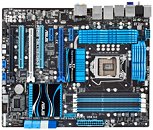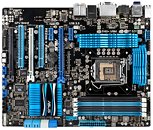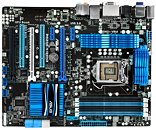Wednesday, September 28th 2011

ASUS Unveils Trio of PCI-Express 3.0 Motherboards Based on Intel Z68 Chipset
ASUS unveiled a trio of socket LGA1155 motherboards based on the Intel Z68 chipset, which feature PCI-Express 3.0 x16 slots (electrical x8/x8 when both are populated). The new motherboards are PCI-Express Gen 3.0 specifications compliant, complete with switches and electrical components. Leading the pack is the P8Z68 DELUXE/Gen3 in the $250-segement, followed by the P8Z68-V PRO/Gen3 in the $200-segment, and the P8Z68-V/Gen3 in the sub-$200 segment.
All three feature 16-phase Digi+ CPU VRM, an Intel-made gigabit Ethernet controller, and Lucid Virtu support. All three feature the same expansion slot loadout, with two PCI-Express 3.0 x16 (x16/NC or x8/x8), one PCI-Express 2.0 x16 (electrical 2.0 x4), and two each of PCI-Express 2.0 x1 and legacy PCI wired to an ASMedia-made bridge chip.The P8Z68 DELUXE/Gen3 is loaded with features, but lacks display connectivity, the bundled Lucid Virtu only works in D-mode, providing load-balancing between multiple installed GPUs. The lack of display connectors creates room for an additional gigabit Ethernet + USB 3.0 port cluster. The second gigabit Ethernet connection is controlled by Realtek 8111E. A PLX-made PCI-Express 2.0 bridge chip is used to create additional PCI-Express 2.0 x1 internal ports, driving additional USB 3.0 and SATA controllers. While the other two boards in this series use ASMedia-made USB 3.0 controllers, the P8Z68 DELUXE/Gen3 uses NEC/Renesas-made ones. Other connectivity includes HD audio, Bluetooth 3.0, and FireWire.
The P8Z68-V PRO/Gen3 is a tiny step down in terms of connectivity options, it gets rid of the RTL8111E-driven gigabit Ethernet connection the DELUXE variant has, makes room for iGPU display connectivity including DVI, HDMI, and D-Sub, and has one fewer eSATA port. The P8Z68-V/Gen3 is even slimmer, its HD audio CODEC lacks DTS decode feature, and it has two fewer SATA 6 Gb/s ports.
Source:
TechConnect Magazine
All three feature 16-phase Digi+ CPU VRM, an Intel-made gigabit Ethernet controller, and Lucid Virtu support. All three feature the same expansion slot loadout, with two PCI-Express 3.0 x16 (x16/NC or x8/x8), one PCI-Express 2.0 x16 (electrical 2.0 x4), and two each of PCI-Express 2.0 x1 and legacy PCI wired to an ASMedia-made bridge chip.The P8Z68 DELUXE/Gen3 is loaded with features, but lacks display connectivity, the bundled Lucid Virtu only works in D-mode, providing load-balancing between multiple installed GPUs. The lack of display connectors creates room for an additional gigabit Ethernet + USB 3.0 port cluster. The second gigabit Ethernet connection is controlled by Realtek 8111E. A PLX-made PCI-Express 2.0 bridge chip is used to create additional PCI-Express 2.0 x1 internal ports, driving additional USB 3.0 and SATA controllers. While the other two boards in this series use ASMedia-made USB 3.0 controllers, the P8Z68 DELUXE/Gen3 uses NEC/Renesas-made ones. Other connectivity includes HD audio, Bluetooth 3.0, and FireWire.
The P8Z68-V PRO/Gen3 is a tiny step down in terms of connectivity options, it gets rid of the RTL8111E-driven gigabit Ethernet connection the DELUXE variant has, makes room for iGPU display connectivity including DVI, HDMI, and D-Sub, and has one fewer eSATA port. The P8Z68-V/Gen3 is even slimmer, its HD audio CODEC lacks DTS decode feature, and it has two fewer SATA 6 Gb/s ports.




15 Comments on ASUS Unveils Trio of PCI-Express 3.0 Motherboards Based on Intel Z68 Chipset
good idea let down my poor software support.
However, on topic. I wonder if USB 3.0 AND SATA III will be the norm yet for making all newer types of hardware. Especially things like HDDs, flash drives, SSDs, etc. so that we can utilize our motherboard's functionality in order to support the usage of USB 3.0 devices :)
I could use virtu, I have a Z68 board. but i dont because currently, its more hassle then what its worth.
then they remove the VGA and DVI connections on the Deluxe mobo and replace it with a network card
If you could SLI or crossfire it with your cards, that would be awesome
but i have 6970s that can deal with all my direct compute tasks :laugh: and if i dont want them to do it i still have overclocked i5 cores.
I can see it that configuration being useful in a lower end performing system with something like a dual core.
but why buy a deluxe board and kit it up with such a slow, locked or dual core CPU? it just doesnt make sense.
Nvidia cards have CUDA so they can handle any encoding.
the only thing that springs to mind is if your GPUs, CPU or both are already encoding and you need to balance the workload out so set up Virtu to do it.
thats some serious encoding.
I've covered MSI and Gigabyte PCIe 3.0, so it only seems to make sense that I cover on of these as well.